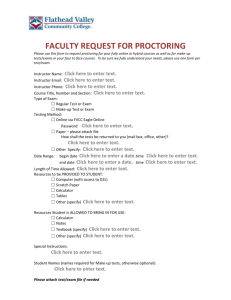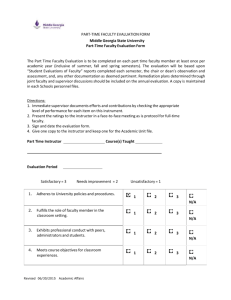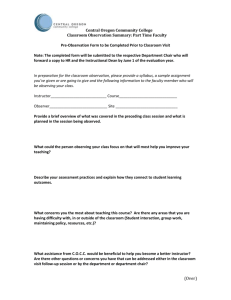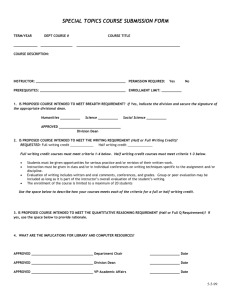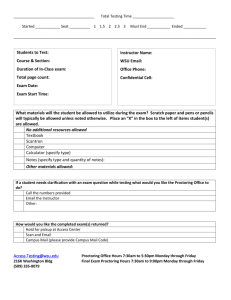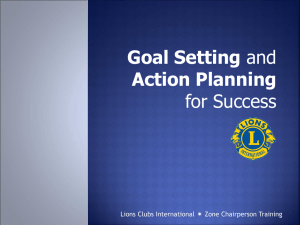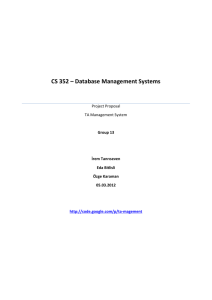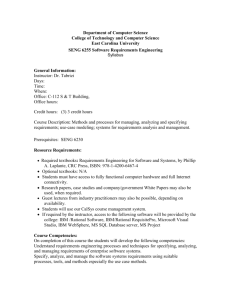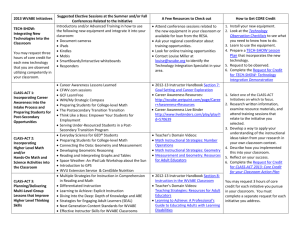Course Request Form
advertisement
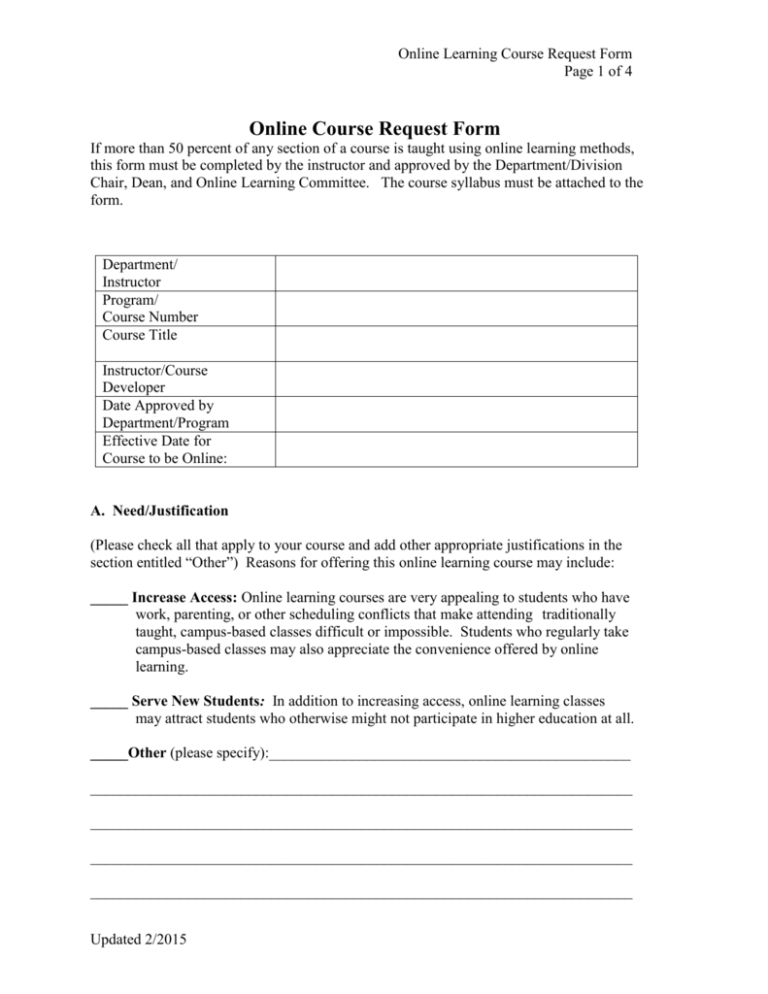
Online Learning Course Request Form Page 1 of 4 Online Course Request Form If more than 50 percent of any section of a course is taught using online learning methods, this form must be completed by the instructor and approved by the Department/Division Chair, Dean, and Online Learning Committee. The course syllabus must be attached to the form. Department/ Instructor Program/ Course Number Course Title Instructor/Course Developer Date Approved by Department/Program Effective Date for Course to be Online: A. Need/Justification (Please check all that apply to your course and add other appropriate justifications in the section entitled “Other”) Reasons for offering this online learning course may include: _____ Increase Access: Online learning courses are very appealing to students who have work, parenting, or other scheduling conflicts that make attending traditionally taught, campus-based classes difficult or impossible. Students who regularly take campus-based classes may also appreciate the convenience offered by online learning. _____ Serve New Students: In addition to increasing access, online learning classes may attract students who otherwise might not participate in higher education at all. _____Other (please specify):________________________________________________ ________________________________________________________________________ ________________________________________________________________________ ________________________________________________________________________ ________________________________________________________________________ Updated 2/2015 Online Learning Course Request Form Page 2 of 4 B. Who is your target population? Include the characteristics of the population you are planning to reach and what knowledge and technical skills you expect them to have in order to successfully complete this course. Also include any prerequisites students should possess prior to enrolling in the course. ________________________________________________________________________ ________________________________________________________________________ ________________________________________________________________________ ________________________________________________________________________ C. Course Design The university has adopted standards regarding the design of a new online class. Will your design meet the below listed criteria? If not, explain what will not comply and why. ____ Yes _____ No (If no, explain) ___________________________________________ ________________________________________________________________________ ________________________________________________________________________ ________________________________________________________________________ ________________________________________________________________________ Design Criteria: 1. The overall course design is made clear to the students at the beginning of the course. The course introduction sets the tone for the course, lets students know what to expect, and provides guidance to ensure they get off to a good start. a. It is clear how to get started and where to find various course components. b. Students are introduced to purpose and structure of the course. c. Etiquette (netiquette) expectations for online discussions, email, and other forms of communication are clearly stated. d. Course and institutional policies with which the student is expected to comply are clearly stated, or link to current policies is provided. e. Prerequisite knowledge in the discipline and/or any required competencies are clearly stated. f. Minimum technical skills expected of the student are clearly stated. g. A self-introduction by the instructor is available (bio/instructor info page, discussion intro, etc.) h. Students are asked to introduce themselves to the class. Updated 2/2015 Online Learning Course Request Form Page 3 of 4 2. Learning objectives are measurable and are clearly stated. Learning objectives establish a foundation upon which the rest of the course is based. a. The course learning objectives describe outcomes that are measurable. b. The module/unit learning objectives describe outcomes that are measurable and consistent with course-level learning objectives. (If unit objectives are in the textbook, it will be sufficient to reference that they are available there) c. Learning objectives are stated clearly and written from the student’s perspective. d. How students can meet the learning objectives are clearly stated. e. Learning objectives are appropriately designed for the level of the course. 3. Assessment strategies are designed to evaluate student progress of stated learning objectives; to measure the effectiveness of student learning; integral to learning process. a. The types of assessments selected measure the stated learning objectives and are consistent with the course activities and resources. b. The course grading policy is clearly stated. c. Specific and descriptive criteria are provided for the evaluation of students’ work; tied to the course grading policy. d. Students have multiple opportunities to measure their own learning progress. 4. Instructional materials are sufficiently comprehensive to achieve stated course objectives and learning outcomes. a. The instructional materials contribute to the achievement of the stated course/unit objectives. b. The purpose of the instructional materials and how they are to be used for learning is clear. c. The distinction between required and optional material is clearly explained. 5. Forms of interaction incorporated in the course motivate students and promote learning. This standard includes student-instructor, student-content, and student-student interactions. Courses should integrate multiple forms of interaction. a. Learning activities promote the achievement of the stated course/unit learning objectives. b. Learning activities provide opportunities for interaction that support active learning. c. Instructor has provided a plan for classroom response time, including feedback on assignments. d. The requirements for student interaction are clearly articulated. 6. Course navigation and technology support student engagement and ensure access to course components. a. The tools and media support the course/unit learning objectives. b. Course tools and media support student engagement and active learning. c. Navigation throughout the online components is logical, consistent, and efficient. Updated 2/2015 Online Learning Course Request Form Page 4 of 4 7. Appropriate security measures are included to ensure academic integrity. a. Assessments are used throughout the course. (not just at the end) b. A variety of assignments and assessment methods are used to increase rigor and provide instructor multiple ways to assess student performance consistency. (not just exams) c. The course adheres to the online course exam proctoring policy (found at http://www.nwosu.edu/Websites/NWOSU/images/OnlineEducation/Onlin e_Course_Proctoring_Policy.pdf) and it is clear which of the exams will have the proctoring requirement. D. Enrollment/Class Size Class size will be determined by the instructor, department chair, and school dean. (Current research indicates that classes of 15-20 are common with 25 considered the maximum that can readily by managed in an online class.) Expected class size _____ Minimum class size _____ Maximum class size _____ Signatures: Person completing this form ________________________________Date ___________ Department Chair ________________________________________Date School Dean ____________________________________________ Date Coordinator of Distance Learning ___________________________ Date ___________ Updated 2/2015
